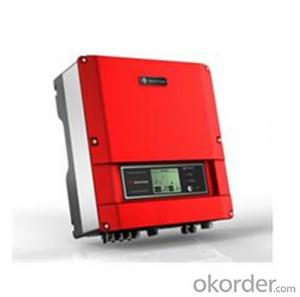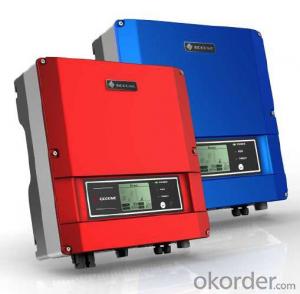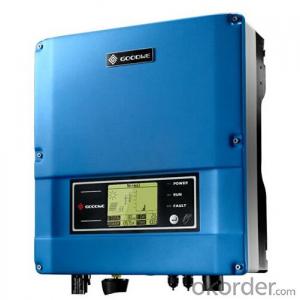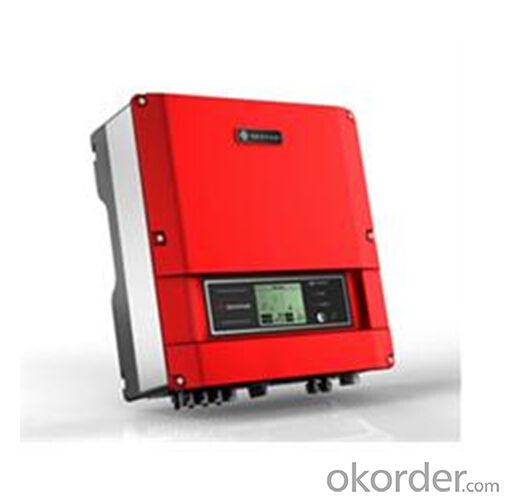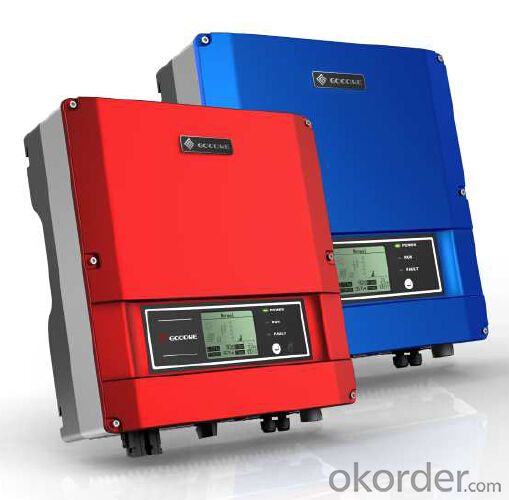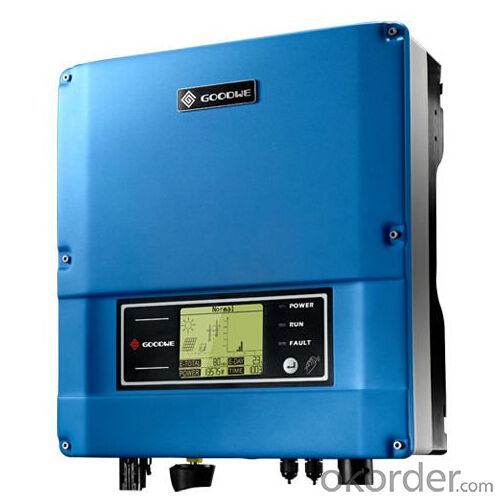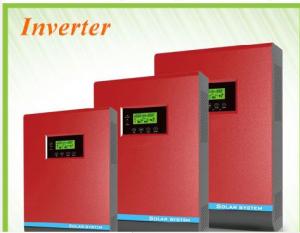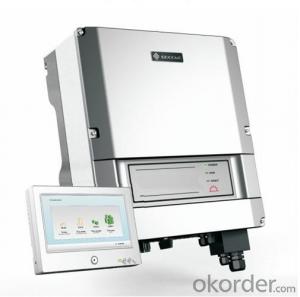Direct Solar Inverter GW4600-DS
OKorder Service Pledge
OKorder Financial Service
You Might Also Like
The DS series has created a new standard for inverter technology with more advanced reactive compensation technology and dual MPP trackers. The new series has a wide range of domestic applications.
Aside from being compatible with most solar panel brands, it also meets the demands of easy installation and simple operation for indoor and outdoor use. Despite its ultra light-weight structure, it meets the IP65 protective class.
Our unique dual MPP trackers and low THDi make DS series the best choice for users to build up perfect photovoltaic systems.
Datasheet
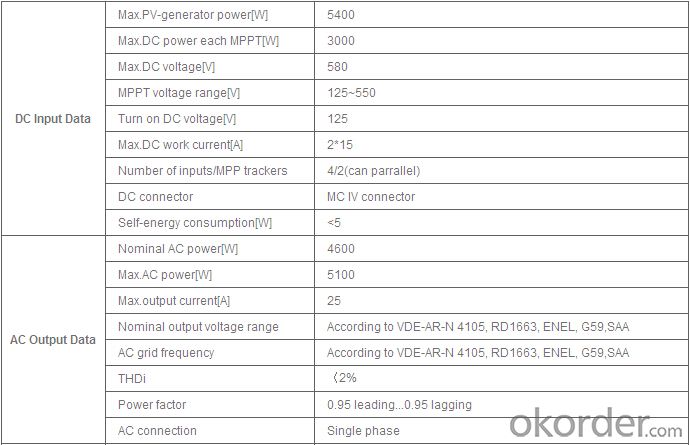
- Q: Can a solar inverter be used with a solar-powered air conditioner?
- Yes, a solar inverter can be used with a solar-powered air conditioner. A solar inverter converts the direct current (DC) produced by solar panels into alternating current (AC) which is required to power the air conditioner. By using a solar inverter, the solar power generated can be utilized efficiently to run the air conditioner, making it a sustainable and cost-effective solution for cooling.
- Q: How does a solar inverter handle variations in temperature?
- A solar inverter handles variations in temperature by employing temperature compensation techniques. It continuously monitors the temperature of the solar panels and adjusts its output voltage and frequency accordingly. This helps maintain optimal performance and efficiency, as temperature changes can affect the electrical characteristics of the panels. Additionally, inverters may have built-in cooling systems or heat sinks to dissipate excess heat and prevent any damage caused by high temperatures.
- Q: Is the grid side of the grid and the inverter?
- Grid-type system power transmission sequence: photovoltaic panels> relays> inverters> relays> electricity load + power grid (both in parallel).
- Q: How do you calculate the power output of a solar inverter?
- To calculate the power output of a solar inverter, you need to multiply the DC input voltage by the DC input current to determine the input power. Then, subtract the inverter's efficiency percentage from 100, divide the input power by this efficiency factor, and you will obtain the power output of the solar inverter.
- Q: Can a solar inverter be used in standalone systems?
- Yes, a solar inverter can be used in standalone systems. Standalone systems, also known as off-grid systems, are not connected to the electrical grid and rely on alternative sources of power such as solar panels. Solar inverters are crucial in standalone systems as they convert the direct current (DC) produced by the solar panels into alternating current (AC) that is used to power household or commercial appliances.
- Q: Are there any fire safety concerns associated with solar inverters?
- Yes, there are some fire safety concerns associated with solar inverters. While solar inverters themselves are not typically a fire hazard, there are a few potential risks to consider. Firstly, improper installation of the solar inverter can lead to electrical issues that may cause a fire. It is important to hire a qualified and certified professional to install the inverter, ensuring that all electrical connections are secure and up to code. Secondly, if the solar inverter is located in an area that is prone to high temperatures or excessive heat, there is a risk of overheating. Inverters generate heat as they convert the direct current (DC) from solar panels into alternating current (AC) for use in homes or businesses. If the inverter is not properly ventilated or if it is exposed to extreme heat, it can overheat and potentially start a fire. Additionally, if there is a fault in the inverter or if it is damaged, it can increase the risk of fire. Regular maintenance and inspection of the solar inverter can help identify any potential issues and ensure its safe operation. To mitigate these fire safety concerns, it is crucial to follow proper installation guidelines, regularly inspect and maintain the inverter, and ensure it is located in a well-ventilated area away from excessive heat sources. It is also advisable to have a fire extinguisher nearby and to have a fire safety plan in place in case of emergencies.
- Q: What is the role of a solar inverter in voltage and frequency regulation during grid disturbances?
- Maintaining the stability and reliability of the electrical grid heavily depends on the crucial role of a solar inverter in voltage and frequency regulation during grid disturbances. To regulate and stabilize the electrical parameters, the solar inverter acts as a control device during grid disturbances like voltage fluctuations or frequency deviations. Regarding voltage regulation, the solar inverter constantly monitors the grid's voltage level and adjusts its output accordingly. It decreases its output if the grid voltage increases to avoid overvoltage conditions. Conversely, if the grid voltage decreases, the inverter increases its output to compensate and maintain a stable voltage level. This regulation guarantees that the solar inverter's voltage aligns with the grid's requirements, preventing harm to electrical equipment and ensuring the grid's safe operation. Similarly, the solar inverter also contributes to frequency regulation during grid disturbances. It continuously monitors the grid's frequency and adjusts its output frequency to match it. If the grid frequency deviates from the standard frequency, the inverter modifies its output frequency to bring it back to the desired level. This frequency regulation is vital to keep various electrical devices connected to the grid synchronized, preventing equipment damage, and ensuring the grid's stability. In summary, the solar inverter's role in voltage and frequency regulation during grid disturbances is to provide stability and reliability to the electrical grid. It acts as a control device that constantly monitors and adjusts its output to maintain the desired voltage and frequency levels. This ensures the prevention of potential damage to electrical equipment and guarantees the smooth operation of the grid.
- Q: Can a solar inverter be used for commercial applications?
- Yes, a solar inverter can definitely be used for commercial applications. In fact, solar inverters are commonly utilized in commercial settings to convert the direct current (DC) electricity generated by solar panels into usable alternating current (AC) electricity that can power various commercial appliances and equipment.
- Q: What are the main components of a solar inverter system?
- Solar inverter systems consist of several key components, namely solar panels, the inverter itself, and various electrical elements. The primary component of a solar inverter system is the solar panel. These panels are composed of photovoltaic cells that transform sunlight into direct current (DC) electricity. To maximize exposure to sunlight, they are typically installed on rooftops or in open areas. Another crucial component is the inverter, which plays a vital role in converting the DC electricity produced by the solar panels into alternating current (AC) electricity, the type commonly used in homes and businesses. Inverters also regulate the electricity flow, ensuring it aligns with the voltage and frequency of the utility grid. In addition to the solar panels and inverter, other electrical components are present in a solar inverter system. These include wiring, switches, fuses, and circuit breakers, which facilitate the connection of the solar panels, inverter, and other equipment to the electrical grid. Monitoring systems and data loggers are often included as well, providing valuable information on energy production and system performance. Lastly, a solar inverter system may incorporate a battery storage system. This allows surplus electricity generated by the solar panels to be stored for later use, such as during periods of low sunlight or power outages. Battery storage systems are gaining popularity as they offer greater energy independence and the ability to utilize solar energy even when sunlight is scarce. In summary, the main constituents of a solar inverter system encompass solar panels, the inverter, electrical elements, and potentially a battery storage system. Each component has a crucial role in harnessing solar energy and converting it into usable electricity for residential and commercial purposes.
- Q: What is the role of a solar inverter in preventing overloading?
- The role of a solar inverter in preventing overloading is to regulate the flow of electricity from the solar panels to the grid or the connected load. It continuously monitors the power output of the solar panels and adjusts the voltage and frequency to match the requirements of the load. By doing so, it ensures that the system does not exceed its capacity, preventing overloading and potential damage to the equipment.
Send your message to us
Direct Solar Inverter GW4600-DS
OKorder Service Pledge
OKorder Financial Service
Similar products
Hot products
Hot Searches
Related keywords
